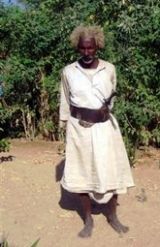Eastern Sudan village engineers its own comeback
Dec 27, 2005 (LATTIT, eastern Sudan) — Two years ago, Lattit’s farms were arid wasteland and its villagers refugees.
 Now, thanks to a new earthen dam, green fields stretch into the distance, producing food for sale and to feed hundreds of families who have returned. And they are reason for hope in a poor and violence-wracked corner of Sudan, and perhaps for other trouble spots in a troubled country.
Now, thanks to a new earthen dam, green fields stretch into the distance, producing food for sale and to feed hundreds of families who have returned. And they are reason for hope in a poor and violence-wracked corner of Sudan, and perhaps for other trouble spots in a troubled country.
Most important, villagers say, they — not aid agencies — made it happen, at one point bargaining with a road crew for use of a bulldozer to build the dam.
“Aid comes in the morning and is consumed by evening,” said Sheik Ali Mussah Hammid, the village headman. But projects led by the community, he believes, can last a lifetime.
“There is no way to compare the two, no way,” he said.
Successive years of drought had devastated this region in the 1980s, forcing thousands of families to leave in search of jobs in cities like Port Sudan on the Red Sea, the hub of the region that is home to the Beja ethnic group.
Fighting in the neighborhood as Eritrea struggled for independence from Ethiopia displaced even more people, and further strained scarce resources.
The Beja rebelled in 1989, complaining the region was neglected. Their war has seen little large-scale violence, but has been troubling for a government fighting insurgents in southern Sudan and in the western region of Darfur. The 21-year southern war ended with a January peace accord, but fighting in Darfur continues, as does the Beja rebellion at a much lower level.
Meanwhile, war drove out nearly all of Lattit’s 500 or so families.
Men left their fields and cattle for low-paying jobs as dockworkers or janitors. Government officials and U.N. studies say almost all the estimated 700,000 people in the Port Sudan region live on less than $1 a day.
Abdullah Issa, a Lattit community leader, said the rehabilitation of this village 140 miles west of Port Sudan started with Sheik Mohamed Tahir, a villager who came back from the city with an education. He proposed damming a creek that runs near Lattit only during the rainy season. A dam would hold water for a few weeks — long enough to soak the land and ready it for cultivation.
A road crew happened to be working in the area, so the villagers offered their well water in exchange for a few weeks’ use of a bulldozer.
Once the dam was complete, villagers in need of tools and seeds approached a U.N. program that offers small loans for projects designed by villagers, such as buying cows or starting a grain mill. U.N. experts advise villagers on how to manage the loans and projects, and loan repayments fund more projects.
“Marginalization and poverty breed conflicts,” says Heba El-Kholy, head of the U.N. Development program in Sudan. “Our work … is part of our conflict prevention strategy.”
The first growing season on Lattit’s reclaimed farmland was a success. Family incomes from selling vegetables were 10 times what they had been from menial jobs in the cities.
The first year, almost every family that had moved away sent at least one member back to work Lattit’s fields. In the second year, entire families came back, and two years later 90 percent are back, said Hammid, the headman. “This is a wonder. We hadn’t realized that miracles could happen.”
Sheik Mohamadin Issa Adam said working as a laborer, deckhand and janitor in Port Sudan often didn’t earn enough to feed his family in the city and he had to take his children out of school. He was so desperate, he says, that “We would have joined anybody, even the rebels.”
Now back in Lattit, he boasts of the 40 sacks of sorghum he harvested his first season, along with vegetables and watermelon. His seven children are studying again.
“Working for someone else cannot be compared to working for yourself, being your own master,” Adam said.
He gestured at his feet as if writing in the sand, the Beja equivalent of swearing on a Bible, and said:
“This is the best thing that has happened to us in the last 20 years.”
(AP/ST)
